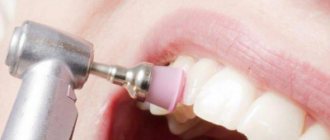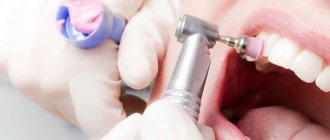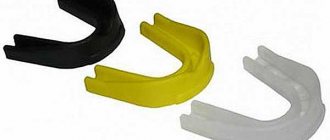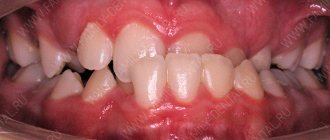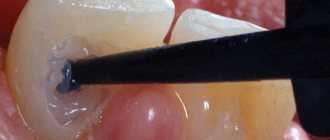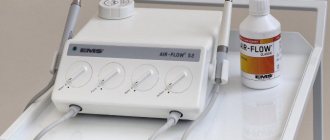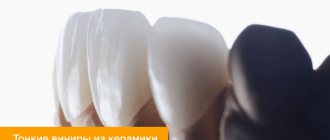Date of publication: 09/28/2018
Tooth filing has been used in dentistry since the 19th century. At that time, the procedure helped treat caries by mechanically removing damaged tissue. Today the technique is used to eliminate other problems, mainly aesthetic ones.
For example, teeth can be filed if one or more units stand out from the general row due to their increased length. Filing can also help with small chips on the edges of the tooth.
In what cases is tooth filing used?
There are different opinions about the advisability of the procedure. It is mainly carried out in the following cases:
- When the upper incisors or canines stand out too much. This not only disrupts aesthetics, but can also interfere with proper bite. In this state of affairs, the teeth can be shortened a little so that they fit better into the dentition.
- If there are small chips on the edges of the teeth. A slight grinding of the enamel will help smooth out the edge.
- If there are sharp corners. Sometimes, due to anatomical features, the front teeth may have protruding parts. They may not look aesthetically pleasing or even damage the cheek.
- For orthodontic bite correction. Sometimes teeth are filed down on the sides to make it easier to move them into the correct position. This is important when installing braces if your teeth are very crowded.
- Filing down the front of the teeth is used when installing veneers. The teeth are also ground down before crowns are installed.
The advisability of filing is determined individually only at the appointment of a specialist.
Cases in which you can straighten teeth without braces
The braces system is the most effective, fastest and painless method for straightening crooked teeth, but many people refuse it for many reasons: they are embarrassed, afraid of discomfort or discomfort associated with eating or while talking.
But there are cases when a person can correct his bite without braces:
- Crooked teeth are only a couple of teeth, not an entire row, so there is no need to wear a complex system;
- The bite only slightly deviates from the norm, but if the bite is open, then braces are still necessary;
- A slight crooked tooth needs to be quickly corrected;
- A person with a “dental” problem is allergic to the metal components that are in braces;
- The gums are located too low, and there is a high probability of injuring them due to the locks of the brace system;
- The patient cannot or does not want to adhere to the rules of wearing and caring for braces;
- The patient wants to look perfect at work or in everyday life, so the use of braces in this case is excluded;
- The patient’s work involves clear and excellent diction (radio DJ, TV presenter, teacher), so he must refuse to wear braces.
Expert opinion
Roman Borisovich Alekperov
orthopedic dentist
Experience: 24 years
If there are indications for filing teeth, it is important to entrust this procedure to an experienced dentist who will correct the aesthetic defect and not cause harm to the teeth. Self-filing is impossible and extremely dangerous - you can seriously damage the tooth, and in the future you will have to resort to microprosthetics or crown prosthetics. There is also a high risk of injury to the mucous membrane and infection.
Veneers
Veneers can also be used to hide minor crooked teeth. Veneers are thin plates of ceramic that are fixed to the teeth using a special glue.
The advantages of this method:
- Does not require a long period of treatment;
- Well hides small cracks, chips and yellow teeth;
- During the entire treatment period, the plates retain their snow-white appearance;
- The adhesive for fixation is absolutely safe, does not cause allergies and is odorless and colorless;
- Does not complicate daily oral care;
- Ceramic plates are very difficult to distinguish from real teeth.
Disadvantages of this method:
- They will not correct complex crooked teeth;
- There is a possibility of records splitting;
- Anesthesia is required during installation;
- Long wearing period;
- If there is tooth sensitivity, then this procedure is prohibited;
- If you have veneers, professional teeth cleaning or whitening is prohibited.
How is filing done?
The technology varies depending on the purpose for which the procedure is performed. The process includes a number of steps:
- - Diagnostics. The doctor determines which teeth will be filed and for what purpose. To do this, a visual inspection is carried out, the cause is studied, and the method of performing the procedure is determined.
- — The area in which manipulation is necessary is determined. For this, carbon paper, wax plates, and special aerosols can be used. This helps to highlight or color an area that, for example, prevents the jaws from closing properly. In difficult cases, a plaster model of the jaw can be made.
- If the procedure requires significant removal of hard tissue, anesthesia is performed.
- Sawing is done using a diamond bur. On chewing teeth, a small layer of enamel on the protruding tubercles can be filed away. If we are talking about incisors, the movements are multidirectional and depend on the situation.
- After the procedure, the surface that was manipulated is polished. Also, remineralizing substances can be applied to the surface of the teeth, as well as compositions to strengthen the surface and reduce sensitivity.
When filing teeth, the thickness of the enamel in the treated areas changes. This may cause increased sensitivity. Usually this is a temporary phenomenon and in the first days it is necessary to refrain from eating hot and cold foods so as not to provoke discomfort and pain. If the problem does not go away over time, you should consult a doctor.
Tooth wear in children: causes
A child’s teeth wear out for the following reasons:
- congenital abnormal bite;
- bruxism (the child often grinds his teeth in his sleep);
- sensitive and fragile tooth enamel due to certain diseases (hypoplasia, etc.);
- genetic predisposition.
Strong abrasion of tooth enamel is caused by straight and deep bites, leading to accelerated exposure of dentin. One of the reasons for the appearance of malocclusion is disturbances in the development of the jaws, which increases the load on the teeth.
A child’s teeth can also wear out due to systemic diseases that reduce the resistance of body tissues: endocrine disorders, diseases of the central nervous system, etc.
Tooth wear can go through several stages.
Online consultation with a doctor
If you are interested in questions about teeth filing, you have been prescribed this procedure, but have doubts about its necessity, or are simply concerned about the condition of your teeth, then it is best to undergo an examination and get advice from a dentist. Under no circumstances should you do the filing yourself. A specialist will assess your dental health, listen to complaints and give professional recommendations. Without a competent opinion, you can complicate the situation, which will lead to illness or already have hidden illnesses. Treatment will be more expensive and, in some cases, longer. At the consultation, the vector of your next actions will be set and doubts will be dispelled.
At home
Fear of doctors and thoughts about the pain of professional manipulations often lead to patients trying to cope with the existing problem on their own. Teeth filing is also no exception.
Dentists share their experience that people often come to appointments whose enamel has been severely damaged by attempts to cut off part of it with various improvised tools in the desire to improve the aesthetic appearance of the jaw row with prominent front teeth or the presence of chips.
In addition to the problem of high sensitivity, these patients experience cracks in the hard tissue, as well as dentin damage, which develops as a result of bacteria entering the dentinal tubules through open pores.
The consequence of such independent actions can be the development of caries, pulpitis and numerous complications that can lead to partial or complete tooth destruction.
Dentists categorically prohibit performing teeth filing procedures at home. Only a specialist can determine the need for an operation to remove a section of enamel and carry it out efficiently, without the risk of complications.
Grinding of teeth for a crown in the gingival area
The edge of the artificial crown in relation to the marginal gum can be located above, at the level of, or extend into the dental gingival sulcus. In the first case, the periodontium is not damaged, but aesthetics suffer. It is possible to compensate for this drawback by introducing the edge of this structure into the groove, but not more than half its depth, which avoids trauma to the dental-gingival attachment.
Another feature of this site is the preparation of the ledge. This is a kind of step that allows you to make an aesthetic and fairly thick edge of an artificial crown. In addition, its edge, ending at a ledge, does not have a harmful effect on the gum, does not push back or injure it. Also, this preparation technique increases the mechanical strength of the installed structure. The ledge can be flat, trough-shaped or beveled at an angle of 135◦. The latter is the most common.
Modern and classic classification of abrasion
In modern Russian practice, the most widespread and popular is the Bushan classification of abrasion, which distinguishes:
✔
physiological abrasion (only enamel is affected);
✔
transitional (enamel + dentin suffers);
✔
pathological abrasion (dentin is damaged).
The benefit of the classification is that, in addition to the degree of pathology, it considers the surfaces (vertical, horizontal) that have undergone changes, the prevalence of the disease and the tooth sensitivity accompanying the process.
As for the types of pathological abrasion, the classical classification was developed by A. G. Moldovanov and L. M. Demner. According to their data, the rate of abrasion is 0.402 mm per year.
- The first degree of abrasion
is achieved by the age of 25-30 and is characterized by smoothing of the cusps and cutting edges of the teeth. - The second degree of abrasion
is observed in patients aged 44-50 years and is expressed in the abrasion of the enamel. - The third degree of abrasion
is noted if by the 50th anniversary the enamel limit has been reached and 10 pairs of chewing teeth have been preserved.
What are the types
There are two ways to carry out separation:
- Mechanical - using a drill with diamond discs, strips or files, a thin layer of enamel (less than 1 mm) is removed from the side surfaces of the incisors.
- Physiological - the interdental spaces expand naturally with the help of wedges, elastic bands, and threads that are inserted into them.
Both methods are practical, but the first method provides instant results. In the second case, you will have to wait several days, so mechanical separation is used more often than physiological separation.
Crown as a way out
Pathological tooth wear can be eliminated with the help of crowns. They can be installed both on the front teeth and on the chewing teeth and restore the aesthetics and functionality of the oral cavity. Crowns can be made from various materials, each of which has its own advantages and disadvantages:
| Material | pros | Minuses |
| Metal ceramics | Durability, high aesthetic qualities, not the highest price | Depulpation of the tooth and grinding of a large amount of hard tissue are required. |
| Metal-free ceramics | The best aesthetics that are not lost over time, high strength, durability. | High price. |
| Metal | High strength, durability, low cost. | Lack of aesthetic qualities. |
When choosing a certain material, the patient must understand that he will need to replace a large number of crowns (perhaps even all). Therefore, it is worth giving preference to those materials that have good aesthetic qualities and a long service life.
After all the nuances of prosthetics have been agreed upon, we proceed directly to the procedure itself. At the first stage, the oral cavity is sanitized and teeth are prepared for crowns. Next, the doctor takes impressions of the jaws, based on which the dental technician makes a prosthesis. These operations may take some time, so the patient may be offered temporary plastic crowns. They will protect prepared teeth from the aggressive environment of the oral cavity and help adapt to new teeth. After the final version of the prosthesis is ready, it is tried on again and fixed with permanent cement.
What and how it is performed on the front upper and lower incisors
Mechanical separation on incisors is performed in one visit to the dentist:
- Using a saw and a drill with a diamond disc (special tip), the side sections of the enamel are removed in an even layer. To prevent injury, the mirror pushes back soft tissue. The file is used less frequently than the vertical attachment of drills, but provides higher accuracy.
- Sawed surfaces are ground and polished. Sanding smoothes out unevenness.
- To protect teeth from hyperesthesia, a strengthening composition is applied to the enamel.
Immediately after the operation, you can see the result - an increase in the space between the incisors. Physiological separation differs in many ways from mechanical separation and takes longer:
- Wedges are inserted into the interdental spaces or they are stretched with rubber bands.
- The patient is sent home for a certain time.
- The wedges are removed and further therapeutic manipulations are carried out.
After the procedure, if it is necessary to correct the bite, an elastic chain is placed on the dentition to close the gaps. They are tightened due to the alignment of the bite over one to four months.
Restoration of worn teeth
Restorative treatment is carried out while preserving at least half of the hard tissues of the tooth. The technique takes place in several stages:
- Preparation. Necessary to identify the causes of diseases and their elimination or minimization, as well as the protection of remaining teeth. During preparation, an occlusal splint is made and installed if the patient suffers from bruxism. If necessary, the doctor prescribes consultations with various specialists, explains the rules of oral hygiene, and sanitizes foci of infection.
- Evaluation of the preparatory stage. After some time, the patient comes for an appointment, and the doctor assesses the condition of the teeth, checks whether the patient followed all the recommendations correctly, and discusses the upcoming treatment with him.
- Restoration. It is carried out in a certain order. First, the teeth are prepared, then the teeth on the upper jaw are restored, and only then on the lower jaw. Using a table of anthropometric data for each tooth, the doctor gives the patient's new teeth a certain length and shape.
- Observation. After successful treatment, the doctor observes the result for some time. In the first year, the patient should come for an appointment once a month, then less and less, but not less than once every 12 months. If any defects are identified, they are repaired or other treatment methods are applied.
This type of treatment, like any other, requires the patient to strictly adhere to all recommendations, give up bad habits, eat right, regular examinations by a specialist, and carefully observe hygiene skills.
Pathological abrasion: consequences
Pathological abrasion – rapid reduction of enamel and dentin, teeth become shorter, sensitivity increases. How to understand that tooth wear has become pathological, and what could be the consequences?
- The surface of the child’s teeth becomes distorted and destroyed, and the edges of the tooth enamel become sharp. This can injure the tongue, as well as the delicate mucous membrane of the cheeks and lips.
- The height of the teeth changes (if the disease progresses), which leads to malocclusion and deformation of the lower part of the child’s face.
- The position of the temporomandibular joint may change, and this can injure the jaw.
- The sensitivity of tooth enamel increases.
Physiology is to blame for everything
To begin with, let's say that all the causes of tooth wear can be divided into two large classes - physiological and pathological.
The first reason appears immediately after the final eruption of baby teeth - and this is a natural process. In children, the incisors, cusps on the canines and molars gradually wear away, and by the age of 6 years, the depth of wear down to the dentin can be observed. In the future, until the age of 14, when the teeth are finally replaced by permanent ones, abrasion of the dentinal layer of the first teeth is sometimes noted. Severe abrasion is diagnosed when the entire upper part of the tooth disappears or the cavity becomes visible.
In general, due to physiological characteristics, teeth adapt to stress during the process of wear. Without dangerous overloads, the work of the entire dental system is adjusted; contacts between teeth change the angle from point to plane, so that the closure of the jaws is more physiological.
If the changes affect only the enamel, there is nothing to worry about. But if dentin begins to participate in the process of abrasion, this is a reason to consult a doctor.
